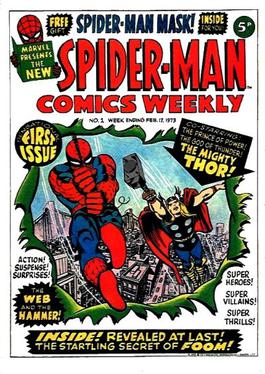| Cole Black Comix | |
|---|---|
| Publication information | |
| Publisher | Rocky Hartberg Productions |
| Schedule | about Quarterly |
| Format | Finite ongoing series |
| Publication date | 1976 - 2006 |
| No. of issues | 10+ |
| Main character(s) | Cole Black Mickey Moorlock |
| Creative team | |
| Written by | Rocky Hartberg |
| Artist(s) | Rocky Hartberg |
| Penciller(s) | Rocky Hartberg |
| Inker(s) | Rocky Hartberg |
Cole Black is an alternative comic book hard-boiled detective created by Rocky Hartberg in 1976. The detective first appeared in the self-published full-sheet newspaper-sized Cole Black Comix #1 (1976) which had a print run of only 200 copies, all distributed in the Aberdeen, South Dakota area. Hartberg submitted Cole Black to Marvel Comics for inclusion in Epic Magazine in the late-1970s. Although Marvel initially like the concept and accepted the submission, changes in editorial direction at Epic Illustrated scrapped the project.[ citation needed ]
In 1980, Hartberg initiated a second Cole Black series, this time in newspaper comic strip format. Between 1980 and 1983, five issues of Cole Black were published in this format. Each of these issues had national distribution and circulated between 1,000 and 1,500 copies. Informed by Bud Plant and other comics distributors that the newspaper strip format was limiting sales, Hartberg prepared African Dream in traditional comic book format. Although intended for publication in 1984 as the concluding chapter of the first story arc, African Dream was dropped in favor of a less fantastic World War II tale. The previously unpublished story was printed in a limited edition by Boardman Books (USA) prior to the sale of Hartberg's original art.
Cole Black returned in volume two in traditional comic format. Although exact numbers are unknown, about 15,000 copies of volume 2, number 1, were distributed worldwide. Two more issues followed in the same format in 1985–1986. Unfortunately, Cole Black was caught in the black and white implosion of the mid-1980s when the highly speculative market for independent black and white comics crashed.
Although poor sales forced Rocky Hartberg to abandon Cole Black in 1986, several full unpublished issues were already finished. Boardman Books (USA) published African Dream as Cole Black: the Missing Issue in September 2006, and in December 2006, they released Cole Black Comics (ISSN 1935-0023) volume 2, number 4, "Charge of the Lady Brigade," cover dated Spring 2007, using art work finished in 1986.

A comic book, also called comicbook, comic magazine or simply comic, is a publication that consists of comics art in the form of sequential juxtaposed panels that represent individual scenes. Panels are often accompanied by descriptive prose and written narrative, usually, dialogue contained in word balloons emblematic of the comics art form.

A graphic novel is a long-form, fictional work of sequential art. The term graphic novel is often applied broadly, including fiction, non-fiction, and anthologized work, though this practice is highly contested by comics scholars and industry professionals. It is, at least in the United States, typically distinct from the term comic book, which is generally used for comics periodicals and trade paperbacks.

Jean Henri Gaston Giraud was a French artist, cartoonist and writer who worked in the Franco-Belgian bandes dessinées (BD) tradition. Giraud garnered worldwide acclaim predominantly under the pseudonym Mœbius and to a lesser extent Gir, which he used for the Blueberry series and his Western themed paintings. Esteemed by Federico Fellini, Stan Lee, and Hayao Miyazaki, among others, he has been described as the most influential bande dessinée artist after Hergé.

Doctor Who Magazine is a magazine devoted to the long-running British science fiction television series Doctor Who. Launched in 1979 as Doctor Who Weekly, the magazine became a monthly publication the following year. Now with 13 issues a year, as well as currently producing triannual deluxe Special Editions (2002–) and Bookazines (2013–), the publication features behind the scenes articles on the TV show and other media, as well as producing its own world famous comic strip. Its founding editor was Dez Skinn, and the incumbent editor is Marcus Hearn, who took over from the magazine's longest-serving editor, Tom Spilsbury, in July 2017. DWM is recognised by Guinness World Records as the longest running TV tie-in magazine, celebrating 40 years of continuous publication on 11 October 2019.
A British comic is a periodical published in the United Kingdom that contains comic strips. It is generally referred to as a comic or a comic magazine, and historically as a comic paper.

An American comic book is a thin periodical originating in the United States, on average 32 pages, containing comics. While the form originated in 1934, American comic books first gained popularity after the 1938 publication of Action Comics, which included the debut of the superhero Superman. This was followed by a superhero boom that lasted until the end of World War II. After the war, while superheroes were marginalized, the comic book industry rapidly expanded and genres such as horror, crime, science fiction and romance became popular. The 1950s saw a gradual decline, due to a shift away from print media in the wake of television and the impact of the Comics Code Authority. The late 1950s and the 1960s saw a superhero revival and superheroes remained the dominant character archetype throughout the late 20th century into the 21st century.
Marvel Comics Presents was an American comic book anthology series published by Marvel Comics originally from 1988 to 1995. It returned for a second volume in 2007–2008, and a third volume that started in 2019.

Archie Goodwin was an American comic book writer, editor, and artist. He worked on a number of comic strips in addition to comic books, and is best known for his Warren and Marvel Comics work. For Warren he was chief writer and editor of landmark horror anthology titles Creepy and Eerie between 1964 and 1967. At Marvel, he served as the company's editor-in-chief from 1976 to the end of 1977. In the 1980s, he edited the publisher's anthology magazine Epic Illustrated and its Epic Comics imprint. He is also known for his work on Star Wars in both comic books and newspaper strips. He is regularly cited as the "best-loved comic book editor, ever."

Epic Illustrated was a comics anthology in magazine format published in the United States by Marvel Comics. Similar to the US-licensed comic book magazine Heavy Metal, it allowed explicit content to be featured, unlike the traditional American comic books of that time bound by the restrictive Comics Code Authority, as well as offering its writers and artists ownership rights and royalties in place of the industry-standard work for hire contracts. The series lasted 34 issues from Spring 1980–February 1986.

The catch-all term adult comics typically denotes comic books, comic magazines, comic strips or graphic novels that are marketed either mainly or strictly towards adult readers. This can be because they contain material that could be considered thematically inappropriate for children, including vulgarity, morally questionable actions, disturbing imagery, and sexually explicit material.

Tor is an American comics series, created by Joe Kubert and Norman Maurer in the story 1,000,000 Years Ago!, published by St. John Publications. The series' protagonist, Tor, is a prehistoric cave man who has fantasy adventures set in a realistically drawn setting. The original series only ran for five issues and ended in 1954. "Tor" was revived by DC Comics in June 1975 for six issues. In June 1993 Marvel Comics released new adventures of Tor.
T.V. Boardman, Ltd. was a London publishing houses that turned out both paperback and hardcover books, pulp magazines, and comic books. Founded by Thomas Volney Boardman in the 1930s, Boardman Books is best known for publishing the long-running monthly series of hardcover Bloodhound Mysteries, most with jacket illustrations by Denis McLoughlin. Boardman's Best American Detective Stories of the Year series is thought by some scholars of the genre to be the best collection of hard-boiled fiction ever published. Boardman published the first British hardcover edition of Robert E. Howard's The Coming of Conan as well as other titles originated by Gnome Press in the United States. Besides mystery, fantasy, and science fiction, Boardman Books published other genres of fiction and nonfiction.
Rocky Ray Hartberg is an American underground comic and commercial artist residing in Langford, South Dakota. He graduated from Northern State University in in 1975 with an art degree. In 2003, Hartberg received a second art degree from Northern.

Star Wars comics have been produced by various comic book publishers since the debut of the 1977 film Star Wars. Marvel Comics launched its original series in 1977, beginning with a six-issue comic adaptation of the film and running for 107 issues, including an adaptation of The Empire Strikes Back. Marvel also released an adaptation of Return of the Jedi and spin-offs based on Droids and Ewoks. A self-titled comic strip ran in American newspapers between 1979 and 1984. Blackthorne Publishing released a three-issue run of 3-D comics from 1987 to 1988.

Fred Hembeck is an American cartoonist best known for his parodies of characters from major American comic book publishers. His work has frequently been published by the firms whose characters he spoofs. His characters are always drawn with curlicues at the elbows and knees. He often portrays himself as a character in his own work, in the role of "interviewer" of various comic book characters. Interviewer Daniel Best has said of his work, "If you take your comic books seriously, and think that those characters are real, then you're probably not a fan of Hembeck."

Miss Fury is a fictional superheroine from the Golden Age of Comics. She first appeared as The Black Fury on April 6, 1941, a Sunday comic strip distributed by the Bell Syndicate, and created by artist June Tarpé Mills. The strip was retitled Miss Fury in November 1941.
The Amazing Spider-Man is a daily comic strip featuring the character Spider-Man which has been syndicated for more than 40 years. It was a dramatic, soap opera-style strip with story arcs which typically ran for 8 to 12 weeks. While the strip used many of the same characters as the Spider-Man comic book, the storylines were nearly all originals and did not share the same continuity. A consistently popular strip, new material was published from 1977 to 2019, with the strip going into reruns afterwards.
Black people have been portrayed in comics since the medium's beginning, with their portrayals often the subject of controversy. Mainstream comic publishing companies have had a historical trend of being predominantly white and male, reflecting the lack of representation and inaccurate depictions of Black people in comics. The integration of black characters in mainstream and superhero comics has endured various obstacles and challenges. Critics have noted that black men and women have historically often been portrayed as jungle or ghetto stereotypes, and as sidekicks as opposed to primary characters. In recent years, with the integration of more Black people in mainstream comic writing rooms as well as the creation of comics on digital platforms has changed the representation and portrayals of Black people in comics and has started to reflect the complexities of Black people across the diaspora.

Spider-Man Comics Weekly was a Marvel UK publication which primarily published black-and-white reprints of American Marvel four-color Spider-Man stories. Marvel UK's second-ever title, Spider-Man Comics Weekly debuted in 1973, initially publishing "classic" 1960s Spider-Man stories.
The Amazing Spider-Man: The Ultimate Newspaper Comics Collection is a series of books collecting the first 10 years of The Amazing Spider-Man newspaper comic strips by Marvel Comics, an American comic strip title which debuted on January 3, 1977. It was first syndicated by Register and Tribune Syndicate (1977–1985), later Cowles Media Company (1986), and currently King Features Syndicate (1987–onwards). The series launched in 2015 and is published by The Library of American Comics.